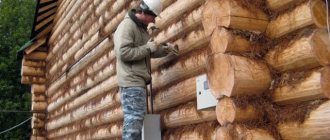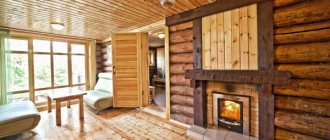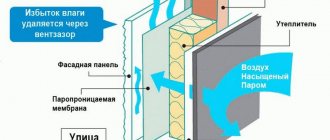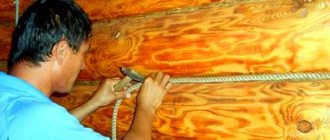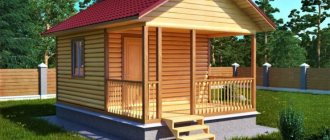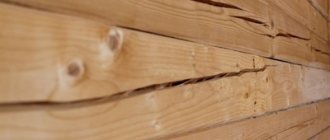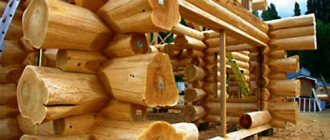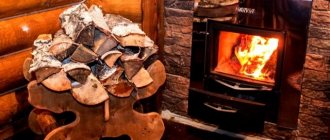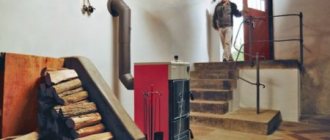The facade of the bathhouse sheathed with natural materials looks aesthetically pleasing and gives the building individuality. A bathhouse made of rounded logs or laminated veneer lumber looks attractive and does not require additional finishing of the facade. But what if the construction was framed or made of cinder blocks? It is necessary to finish the bath and give it an aesthetic appearance. There are a lot of finishing materials on the market, but making a choice on your own can be difficult. How to cover the outside of a bathhouse, what materials are suitable, their features, pros and cons, we will consider together with our readers.
Is external insulation necessary?
Baths come in different types: wooden, frame, built of brick and concrete blocks. And they are used in different ways: some often and throughout the season, others only in the summer, once a week. Before you can cover the outside of a bathhouse cheaply and beautifully (or expensively and solidly), you need to resolve the issue of the need for its external thermal insulation. Then it will be more difficult to do this - you will have to remove and redo the decorative cladding.
When thermal insulation is not required
It is clear that summer baths, even those used daily, do not need insulation. But not all all-season buildings need it.
- Log or timber bathhouse.
They are dressed in a “fur coat” only for commercial use, when it is important to keep warm constantly and spend less money on heating. To insulate private baths, high-quality caulking of the seams is sufficient to prevent heat leakage through the cracks. Wood has very low thermal conductivity, it “holds” the temperature inside the steam room well and does not allow frosty air from the street to penetrate. And if the frequency of fires does not exceed 2-3 times a week, there is no point in external insulation.
A log house made of timber with windproof seams does not need to be insulated Source i1.wp.com
- Frame bath.
In such structures, thermal insulation material is already part of the structure.
- Periodic baths.
If you steam no more than once a week, it makes no sense to insulate the bathhouse from the outside, regardless of the material of the walls. During this time, it will freeze through in any case, unless you maintain a positive temperature in it with heating devices. Therefore, you don’t have to worry about this and think only about how best to line the outside of the bathhouse.
When is it better to insulate a bathhouse?
It is necessary to insulate the walls from the outside if:
- the sauna is heated frequently and it is necessary that it does not get too cold between sessions, especially if there is water left in the tank;
- the number of steamers in a family or company is large, the procedure takes a long time and it is necessary to maintain the desired temperature all this time.
In such cases, external thermal insulation significantly reduces fuel consumption, which ultimately saves money and simplifies the work of the stoker. It is especially needed for buildings built from heat-intensive materials - concrete, stone, brick.
High-quality insulation saves the bathhouse owner’s energy, time and money Source yandex.net
On a note! Particularly effective is double insulation along the internal and external contours of the walls or the use of a reflective screen made of foil insulation under the internal cladding.
Strip foundation
Such a foundation is installed when there is heaving soil on the plot.
The work on its construction is carried out step by step:
- Markings are made on the site and a trench is dug, the width of which is 40 centimeters and the depth is approximately 50 centimeters.
- The hole is filled with sand layer by layer until the ground level is reached, compacted each time and watered with water to ensure compact shrinkage.
- They construct formwork 50 centimeters high and 30 centimeters wide. For greater strength, it is reinforced using rods and metal pipes.
- Pour the concrete solution in several approaches (without allowing the previous layer to dry) or at a time.
- Roofing felt is laid on top of the concrete to waterproof the frame walls.
Projects and drawings of a two-story frame bathhouse provide for the provision of the most reliable support on any type of soil, with the exception of floating ones. The base is a prefabricated strip foundation.
Types of insulation for external finishing
If you decide to insulate the walls before covering the outside of the bathhouse with corrugated board, clapboard or siding, you need to figure out how to do it correctly. Otherwise, you can end up with a disturbed microclimate in the steam room, wet walls and corroding or rotting cladding.
The choice of insulation and its installation technology depends on the material of the load-bearing walls, their heat capacity, vapor permeability and permissible moisture accumulation.
For wooden walls
Wood has high vapor permeability and quickly begins to rot when wet. This applies to both the walls themselves and the wooden external cladding. Therefore, the insulation laid between them must allow steam to pass through. And between it and the finishing there must be a ventilation gap through which the steam is released into the atmosphere. This is the basic principle of ventilated facades. Only such an exterior finishing scheme is applicable to log houses, regardless of the presence or absence of thermal insulation.
Installation of a suspended ventilated facade with insulation Source derevyannyydom.ru
Wooden structures can only be insulated from the outside with mineral wool, since the vapor permeability of this material is higher than that of wood.
It is important! The difference in partial pressure in the steam room and outside, especially on cold days, is very large, so the steam from inside tends to escape through the walls. The insulation should not retain it, otherwise moisture will settle on the logs and they will begin to rot. This is what happens when thermal insulation is made with expanded polystyrene or penofol.
All layers of exterior finishing are visible in the picture.
- Frame - attached to the walls at equal distances equal to the width of the insulation.
- Insulation is placed in the spacer between the frame slats.
- A waterproofing membrane , which releases steam but does not allow moisture from the air into the insulation, is applied to the sheathing with an overlap and gluing of the joints.
- Counter-lattice - slats stuffed onto the frame over the membrane, create a ventilation gap and serve as the basis for attaching the external finish.
It doesn’t matter what you can cover the outside of a bathhouse on top of such a “pie” - any façade material will do. But it must be selected before the counter-lattice is installed, since the recommended pitch between the racks may differ.
The direction of fastening the load-bearing elements of the frame - horizontal or vertical - depends on the sheathing material. Source uteplili.ru
For concrete and brick walls
Bricks and blocks made of heavy concrete have high heat capacity and resistance to moisture, but low vapor permeability. External finishing with mineral wool insulation under a hinged ventilated façade is also applicable to such walls. But a much cheaper option is with a “wet” facade - plaster over a slab vapor-tight heat insulator.
As a rule, this is foam plastic, which is glued to the outside of the walls and secured with dowels with a wide head. Plastering is carried out on a reinforcing mesh.
Scheme of a “wet” façade Source ibb.co
If you don’t want to get involved with wet processes, you can stuff a frame onto the rough walls, put rigid insulation into its cells, fill all the joints between it and the sheathing bars with polyurethane foam, and then perform cladding on this frame. In this case, no waterproofing films are used.
The pitch of the frame depends on what the outside of the bathhouse is lined with. Source indclimat.ru
Note! Despite the moisture resistance of concrete and brick, they should not be allowed to become waterlogged. Therefore, the walls are covered from the inside with a foil screen, and the thickness of the external insulation is selected taking into account climatic conditions, ensuring that the dew point moves into it. At winter temperatures reaching -30 degrees, it should be at least 200 mm.
For walls made of lightweight cellular concrete
According to their physical characteristics, foam concrete and aerated concrete are between wood and heavy concrete. The similarity with wood lies in the high vapor permeability of the materials, which makes it undesirable to insulate such walls from the outside with polystyrene foam. The steam released by the walls does not pass through it, but remains in the blocks, disrupting their structure when freezing.
It is better to use mineral wool with a ventilated facade or warm “breathable” plaster for this. In this case, it is advisable to protect the cotton insulation with a vapor barrier film on the side of the load-bearing wall.
For reference! Ideal for a bathhouse made of cellular blocks is internal insulation with waterproofing and ventilation of the frame space.
Internal insulation of a bathhouse with a heat-reflecting and waterproofing foil screen Source wp.com
See also: Catalog of companies that specialize in the construction of bathhouses and insulation and finishing work.
conclusions
A log bathhouse, built in Russian traditions, as a rule, does not require additional insulation of the walls either outside or inside.
When choosing external insulation for a brick or block bathhouse, the choice is very wide. Without harming your health, you can use mineral wool made using phenol-formaldehyde resins, which is not recommended for insulating the inside of a bathhouse. Styrofoam and polystyrene foam are also suitable.
If you have the financial means, the bathhouse can be covered with a metal block house, which will serve for many years.
Materials for external cladding
A real Russian bathhouse is built of wood. And if it is built correctly, from high-quality material, then cladding inside and outside a timber bathhouse or log house is not needed. However, wood also ages over time, loses its appearance and requires finishing. And even more so for buildings made from other materials.
If we discard the idea of external plaster and focus on cladding technology, then it should be carried out according to the principle of a suspended ventilated facade - with an air gap between the load-bearing wall (or insulation) and the cladding material.
This is especially true for a bathhouse, since water vapor greatly increases in volume when heated, creates excess pressure and tends to escape through the walls. It needs to be given the opportunity to evaporate in the atmosphere, to erode, and not settle on structures. This is why an air gap is needed.
Log house of a Russian bath - beautiful and warm without decoration Source banya-ili-sauna.ru
Therefore, any facing material described below for a bathhouse is attached to a specially mounted frame.
Vinyl siding
This is one of the best options if you need to decide how to cover the outside of a bathhouse inexpensively, but stylishly and beautifully. Vinyl wall panels are produced by different manufacturers and differ in price, color schemes, and geometric parameters. On average, they are about 20 cm wide and cost from 120 rubles for a panel 270 cm long (220 RUR/m²).
The assortment of domestic and foreign manufacturers includes many shades of siding and types of profiles. It can imitate timber, lining, block house, herringbone cladding, etc.
Different profiles of vinyl siding Source standart40.ru
Advantages of the material:
- simple installation;
- weather resistance;
- resistance to any corrosion processes;
- color fastness;
For reference! Panels in pastel colors retain color better, while those painted in bright colors fade over time.
- the absence of cracks in the cladding for moisture and dust to penetrate under it;
- non-toxic material;
- unattractive to rodents, insects and microorganisms.
There are also disadvantages. If we talk about price, then the wall panels themselves are inexpensive, which cannot be said about additional elements for framing corners, openings, eaves overhangs and other structural elements of the building. They can cost the same amount as the main material.
Another significant disadvantage is the large number of scraps when the multiplicity of panel lengths and wall sizes do not match.
Finally, the recommended sheathing pitch for vinyl siding is 40 cm, which does not coincide with the frame pitch for installing insulation (50-60 cm).
Advice! It is better to make the frame for installing insulation under vinyl siding horizontal. Then the racks can be mounted on them vertically at any convenient pitch.
An example of wall insulation under siding. Source mainavi.ru
Why do you need a bath lining?
Over time, natural wood darkens and loses its appearance, so it must be sheathed on top.
A new building made of brick, wooden beams or logs does not require external sheathing, because it looks beautiful. Over time, the wood darkens, becomes unattractive, and begins to deteriorate from weather factors. The brick surface also ages, the mortar in the joints cracks and falls out. To update the facade, modern materials are used that emphasize the individuality of the building.
If the bathhouse is built from foam block, cinder block or aerated concrete, the structure must be finished immediately, because the stones have a gray and boring appearance, such a building will not be able to decorate the site. Foam concrete is characterized by increased resistance to moisture, which cannot be said about aerated blocks. This wall material requires external waterproofing from rain, which is always combined with different options for finishing the bathhouse outside.
As a result, it becomes possible to set layers:
- heat-insulating material;
- waterproofing gasket;
- windproof film;
- soundproofing membrane.
Sheathing on a frame made of slats or profiles helps solve the problem of insulating external wall surfaces. The purpose of the outer cladding is to achieve the effect of a thermos; without this result, the bathhouse will not provide the required functionality.
Video description
Before covering the outside of a timber bathhouse with siding, we recommend watching a training video on this topic:
Metal siding and profiled sheet
Until recently, metal was not used as facade finishing for residential buildings and outbuildings (except for garages). But with the advent of corrugated sheeting and metal siding, everything changed. Now it is not just an inconspicuous steel sheet, but a composite material with an expressive relief and colored polymer coating, which not only gives the product a beautiful appearance, but also protects it from corrosion.
If you need to find a relatively inexpensive, practical and durable material, then you can’t think of anything better than lining the outside of a wooden bathhouse with metal sheets and panels.
Siding that qualitatively imitates a log house Source polimarkural.ru
Today, these materials are produced everywhere; production can be found in the nearest city or town. And order products that exactly match the length or height of your building. Most enterprises offer factory-cut siding or corrugated sheets from 50 cm to 6 meters or more in length. This makes it possible to eliminate the generation of waste even when covering inter-window partitions and other difficult sections of the wall.
Moreover, the cost of these materials is comparable to the price of vinyl siding: metal panels will cost 310-380 rubles/m², and corrugated sheets will cost 200-300 rubles/m². Additional elements for steel facades are cheaper than plastic ones, so in total the external cladding will cost less.
As for installation, the technology for attaching metal and vinyl siding is similar. But in the case of steel panels, there is the possibility of both hidden and open installation of corners, near-window strips and other additional elements.
How to calculate quantity
This is a fairly trivial task. The area is the product of one side of the rectangle and the other. Each surface that you are going to cover with clapboard is a rectangle (be it a wall or a ceiling).
Be sure to subtract from it the empty space of door and window openings.
The remaining area is summed up, giving us the number of square meters of future lining. This is in general.
But if you know the length and width of one plank, then you may want to know how many planks you need to buy. To calculate the amount of lining for a bathhouse “in slats”, you need to decide in which direction it will be laid and divide this side by the width of the slats. This gives you the number of planks on the wall.
And the other side of the wall or ceiling will show how much will need to be cut from the full length of the plank. It’s good if the plank is divided in half or there is room for the trim on another wall.
In general, draw a plan for your bathhouse , estimate the number of slats and compare it with the length of the lining that can be found on sale. And then start adapting this length to your needs so that there is less waste.
IMPORTANT! The higher the grade, the less waste, but you must always be prepared for the fact that some of the material will be unusable for one reason or another. Therefore, you need to take a little more lining than was calculated. The minimum excess is 5% .
But you can immediately see from the quality how much will go to waste, so feel free to add extra interest. Or just take an expensive one. Because the same AB grade has many surprises in store in sealed plastic packaging.
Video description
How walls are covered with metal siding is shown in the video:
In contrast, a profiled sheet is attached vertically, with the sheets simply overlapping each other along the wave relief and through fixation with self-tapping screws with a rubber washer and a painted head. Therefore, the frame under it is mounted in the form of a horizontal sheathing with a convenient step of 50-60 cm.
Scheme of wall cladding with corrugated sheeting Source iblogger-ok.ru
Wood paneling
Wood is a traditional material for finishing the facades of residential buildings and baths. It remains popular, despite the emergence of cheaper and more practical analogues - vinyl and metal siding that imitates wood paneling.
Most often, it is chosen when you need to decide how to sheathe the outside of a frame bathhouse, since it adds another warm layer to the thermal insulation pie and fits perfectly with the wooden elements of the building’s frame.
The lining material used is mainly lining, imitation timber and block house made of coniferous wood.
- Lining.
This is the most affordable type of wooden panels, which can have different profiles. The cost per square meter, depending on the species and type of wood, is from 280 rubles (pine) to 700 rubles (larch).
- Imitation of timber.
The panels are thicker than conventional lining, and their assembled profile imitates a timber frame. Sheathing with this material will cost much more - 400-500 rubles/m² (pine) with a 20 mm thickness.
Finished walls cannot be distinguished from those made of timber Source hozsektor.ru
Scandinavian style
Scandinavian style is characterized by laconicism, plenty of light, natural materials and colors. For finishing the facade, choose light monochrome or wood shades. The decor is replaced by large, often panoramic windows.
Video description
We recommend seeing how to properly sheathe frame buildings with wood:
It is important! Before installation, antiseptic compounds should be used to impregnate not only the cladding panels, but also the sheathing slats and other wooden structures hidden under the cladding.
The installation principle is that after installing the first board level, it is fixed on the groove side with nails driven at an angle or with clamps and self-tapping screws. Then the tenon of the next panel is tightly inserted into this groove and, after checking the level, secured in a similar way. This is how the cladding is installed along the entire height or length of the wall.
Internal and external corners, framing of openings are made of polished edged boards.
Upon completion of finishing, the facade is decorated with tinted impregnations, varnishes or acrylic paints for exterior use.
When choosing what you can use to cover the outside of a bathhouse inexpensively, it is worth considering options for finishing it with regular boards - edged or unedged. There are at least two ways to create attractive and practical facades from them.
- Herringbone paneling.
This method involves horizontal installation of boards with overlap. The bottom board is attached to the sheathing level, and each subsequent board is laid on it with its lower edge and fixed through with galvanized nails or self-tapping screws.
In the same style as the house
Bath buildings look harmonious and stylish, as close as possible in architecture to residential buildings. The bathhouse does not stand out from the general ensemble. It can easily be mistaken for a guest house or a closed summer kitchen.
Video description
How to properly perform herringbone cladding, watch the video:
- Cladding with strips.
In this case, the vertical direction of fastening to the horizontal sheathing is preferable. The boards are attached to it with indentations from each other, after which the resulting gaps are covered with the next row of boards. The result is a staggered installation. It looks quite interesting and unusual, especially when using unedged boards.
Vertical cladding of a bathhouse with unedged boards with flashings Source ibb.co
Facade panels
If you do not have financial problems, you can cover the outside of the bathhouse with more expensive and solid materials used for finishing the facades of residential buildings. This may be justified if you want to give all buildings on the site a uniform look and style.
Such materials include various facade panels made of composite materials - fiber cement, vinyl, WPC, clinker, etc.
- WPC panels.
WPC is a wood-polymer composite made from wood flour and a polymer binder in different proportions. Such panels are characterized by high strength, low thermal conductivity, wear resistance, they do not deform, do not rot, and are easy to clean. Available in the form of hollow boards with a hidden installation system. Costs may vary depending on the percentage of components. On average it is 1200-1400 rubles/m².
WPC facade panels Source gardeck.ru
Using a block house
The material has high strength, aesthetics and reliability. If you complete the finishing using a block house, then you no longer have to worry about safety. Cladding is well suited for updating the facades of old buildings. Over time, the material does not deform. During the production process, the panels undergo a drying procedure, which reduces their humidity and makes work easier.
Among the advantages of a block house, ease of installation and aesthetics should be highlighted. Even a non-professional can handle the work. During the first stage of installation, the material is left to acclimatize for several days. Then the walls are waterproofed, lathing is installed on their surface and a moisture-proof film is installed. At the next stage, the craftsmen begin installing the counter-lattice, which provides a ventilation gap. Installation of the block house is carried out at the final stage.
Briefly about the main thing
When choosing an external finish for a bathhouse, the issue of the need for external insulation is first decided.
In most cases, it is necessary to leave an air gap between the insulation and the facade materials to ventilate it.
Most often, practical modern materials such as vinyl and metal siding and corrugated sheets are used for cladding.
Wooden panels also remain popular, but they are more expensive and require constant maintenance.
OSB and DSP boards are quite suitable as inexpensive or temporary finishing, and façade panels made of fiber cement, wood-polymer composite or slab insulation with stone finishing will give the bathhouse the most solid look.
Ratings 0
Contrasting façade design
There are several ways to add color when decorating a facade:
- Siding.
- Painting with facade paint.
- Tinting with protective impregnations and glazes.
- Use of contrasting additional elements.
It is important not to overdo it with this method. The landscape environment and color design of other buildings should echo the facade of the bathhouse. Single buildings in too bright colors look awkward.
Preparing the structure
So what's important to know?
Stages of work
| The walls should be as smooth as possible | Only then can high-quality fastening of the sheets be achieved. If you plan to finish a wooden structure, it is better to wait for it to completely shrink. Otherwise the structure will look bad. |
| Between the caps and panels of the parts you need to leave a small space (about 1 cm) | Temperature changes can cause siding to warp. |
Having familiarized yourself with these requirements, you can proceed to preparing the bath.
Here are the important points to remember:
- There should be no cracks or holes in the walls, otherwise the panels will be attached unstable.
- It is better to choose self-tapping screws or nails made of stainless steel. They must be at least 30 mm in length and at least 8 mm in diameter.
Tools required for installation:
- Hammer.
- Spring center punch.
- Scissors for cutting metal.
- Roulette and hammer.
- Parts for fastening.
- Punch punch for perforation.
- Stapler for construction work.
Wooden siding for a bathhouse is best suited for cladding.
First, measurements are taken:
- It is necessary to measure the walls.
- Window.
- Broken and triangular pediments.
- Soffits are also calculated.
Here are instructions that will help you correctly calculate the required amount:
- Having received the overall dimensions of the walls (this includes width and height), it is necessary to calculate the working area. To do this, use the formula S= wall length * wall height.
- Using the same principle, the size of the remaining walls is calculated, then the indicators are added up and the main footage is obtained.
- Then you need to calculate the area of doors and windows. The resulting number is subtracted from the area of the walls of the building.
- The same formula is used to calculate the area of one siding panel.
- The area of the house is divided by the area of the panel, the number that is needed is obtained.
| Bath length | Bath width | Height | total area | Area of doors and windows | Quantity of material required |
| 8 | 5 | 3 | 24 | 7 | 17 |
| 9 | 8 | 3 | 27 | 9 | 18 |
| 15 | 12 | 3.5 | 52.5 | 15 | 37.5 |
Before starting work on installing siding for a bathhouse, you need to be well prepared:
- Remember that the finishing of the external walls of a wooden bathhouse begins only after it has completely settled.
- Make sure that there are no cracks in the walls of the bathhouse and that the surface is completely flat. Otherwise, the finish will look crooked and adhere unsteadily to the sheathing.
- For the sheathing you will need a punch, hammer, tape measure, fasteners, spring punch, tin snips, staple gun, punch and level.
- Fasteners (nails, screws) must be made of stainless steel. Their length must be at least 30 mm, and the diameter of the cap must be at least 8 mm in diameter.
Important requirements when working with simulation wood
- Accurate calculation of the amount of material;
- The bathhouse is covered with panels arranged horizontally, with the spike facing up;
- Fastening is carried out on a flat surface to the erected sheathing;
- If the sheathing is made of wood, then it is coated with an antiseptic;
- All protective compounds must be applied to the imitation timber before installation; this will provide protection not only to the front side, but also to the joints and the rear part.
Tags: bathhouse, frame, finishing, outside
« Previous entry
Selection and installation of lathing
The sheathing is a supporting structure for the installation of sheathing, which simultaneously performs:
- Leveling function in the presence of deficiencies in the geometry of the walls.
- Forming a ventilation gap.
- Supporting insulating material (not the most successful method, but used quite often).
The sheathing design is a one- or two-layer system of planks. The first layer is leveling, it forms a plane and supports the insulation. The second layer is installed across the first, it forms a ventilation gap and directly carries the sheathing.
The material can be used wooden blocks or, which is much more effective, metal guides for gypsum boards. The sheathing is installed on pre-installed brackets or direct hangers for gypsum boards. To fasten the planks, self-tapping screws with a drill tip are used.
